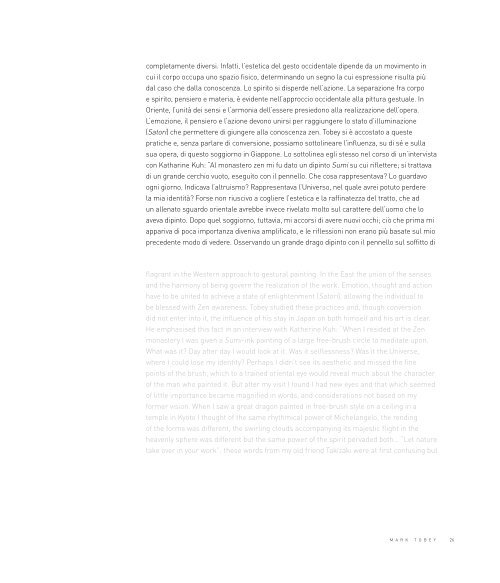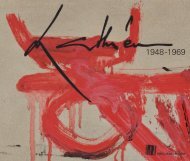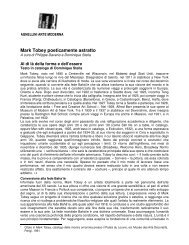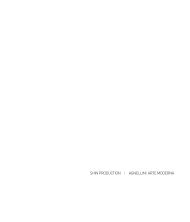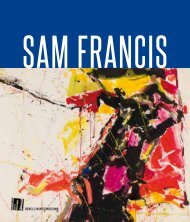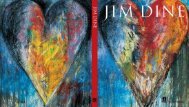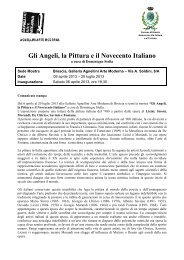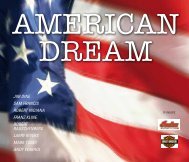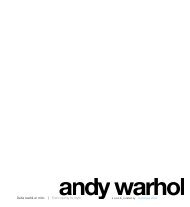Shin production | Agnellini Arte ModernA - Galleria Agnellini Arte ...
Shin production | Agnellini Arte ModernA - Galleria Agnellini Arte ...
Shin production | Agnellini Arte ModernA - Galleria Agnellini Arte ...
Create successful ePaper yourself
Turn your PDF publications into a flip-book with our unique Google optimized e-Paper software.
completamente diversi. infatti, l’estetica del gesto occidentale dipende da un movimento in<br />
cui il corpo occupa uno spazio fisico, determinando un segno la cui espressione risulta più<br />
dal caso che dalla conoscenza. lo spirito si disperde nell’azione. la separazione fra corpo<br />
e spirito, pensiero e materia, è evidente nell’approccio occidentale alla pittura gestuale. in<br />
oriente, l’unità dei sensi e l’armonia dell’essere presiedono alla realizzazione dell’opera.<br />
l’emozione, il pensiero e l’azione devono unirsi per raggiungere lo stato d’illuminazione<br />
(Satori) che permettere di giungere alla conoscenza zen. tobey si è accostato a queste<br />
pratiche e, senza parlare di conversione, possiamo sottolineare l’influenza, su di sé e sulla<br />
sua opera, di questo soggiorno in giappone. lo sottolinea egli stesso nel corso di un’intervista<br />
con Katharine Kuh: “Al monastero zen mi fu dato un dipinto Sumi su cui riflettere; si trattava<br />
di un grande cerchio vuoto, eseguito con il pennello. che cosa rappresentava? lo guardavo<br />
ogni giorno. indicava l’altruismo? rappresentava l’universo, nel quale avrei potuto perdere<br />
la mia identità? Forse non riuscivo a cogliere l’estetica e la raffinatezza del tratto, che ad<br />
un allenato sguardo orientale avrebbe invece rivelato molto sul carattere dell’uomo che lo<br />
aveva dipinto. dopo quel soggiorno, tuttavia, mi accorsi di avere nuovi occhi; ciò che prima mi<br />
appariva di poca importanza diveniva amplificato, e le riflessioni non erano più basate sul mio<br />
precedente modo di vedere. osservando un grande drago dipinto con il pennello sul soffitto di<br />
flagrant in the Western approach to gestural painting. in the east the union of the senses<br />
and the harmony of being govern the realization of the work. emotion, thought and action<br />
have to be united to achieve a state of enlightenment (Satori), allowing the individual to<br />
be blessed with Zen awareness. tobey studied these practices and, though conversion<br />
did not enter into it, the influence of his stay in Japan on both himself and his art is clear.<br />
he emphasised this fact in an interview with Katherine Kuh: “When i resided at the Zen<br />
monastery i was given a Sumi-ink painting of a large free-brush circle to meditate upon.<br />
What was it? day after day i would look at it. Was it selflessness? Was it the universe,<br />
where i could lose my identity? perhaps i didn’t see its aesthetic and missed the fine<br />
points of the brush, which to a trained oriental eye would reveal much about the character<br />
of the man who painted it. but after my visit i found i had new eyes and that which seemed<br />
of little importance became magnified in words, and considerations not based on my<br />
former vision. When i saw a great dragon painted in free-brush style on a ceiling in a<br />
temple in Kyoto i thought of the same rhythmical power of Michelangelo, the rending<br />
of the forms was different, the swirling clouds accompanying its majestic flight in the<br />
heavenly sphere was different but the same power of the spirit pervaded both… “let nature<br />
take over in your work”: these words from my old friend takïzaki were at first confusing but<br />
m a r k t o b e y 26 27 m a r k t o b e y<br />
un tempio a Kyoto, pensai alla stessa forza ritmica di Michelangelo: la rappresentazione delle<br />
forme era diversa, le nuvole vorticose che accompagnavano il suo maestoso volo nella sfera<br />
celeste erano diverse, ma vi era la medesima forza spirituale… “lascia che la natura assuma<br />
il controllo del tuo lavoro” queste parole del mio amico takïzaki in un primo momento mi<br />
disorientarono, ma poi si esemplificarono nel concetto di “lasciar libero il passaggio”.<br />
oggi alcuni artisti parlano dell’“atto del dipingere”. Questo, nel migliore dei suoi significati,<br />
potrebbe comprendere ciò che il mio vecchio amico intendeva. Ma la preparazione principale<br />
è lo Stato d’Animo e l’azione procede da questo. la “pace interiore” è un altro ideale, forse lo<br />
stato ideale da ricercare nella pittura, e certamente è preparatorio all’atto del dipingere” 2 .<br />
Mark Tobey e la storia dell’Informale<br />
in questa lettera tobey fa riferimento agli artisti americani dell’Action painting. certe forme della<br />
sua arte possono suggerire una similitudine con alcune opere di pollock ma, come egli stesso<br />
sottolinea, lo spirito che guida la creazione è completamente diverso, addirittura antinomico. i<br />
drippings di pollock sono costruiti a partire da proiezioni di pittura sulla tela. i quadri prendono la<br />
forma di arabeschi colorati, realizzati su una tela posta direttamente per terra, in cui non prevale<br />
alcun senso di lettura. Jackson pollock è uno dei rappresentanti di ciò che il critico harold<br />
cleared to the idea, “get out of the way”. We hear some artists speak today of the “act of<br />
painting”. this in its best sense could include the meaning of my old friend. but a State of<br />
Mind is the first preparation and from this the action proceeds. “peace of Mind” is another<br />
ideal, perhaps the ideal state to be sought for in the painting and certainly preparatory to<br />
the act” 2 .<br />
Mark Tobey and the history of Informal art<br />
in this interview tobey makes reference to the American action painters. certain forms in<br />
his art bear affinities to the works of pollock but, as he himself underlines, the mind that<br />
guides the creation is totally different and even antinomic. pollock’s drippings are built up<br />
starting from splashes of paint on the canvas. the paintings take the form of interlaced<br />
colours, applied to the canvas stretched out on the ground, in which there is no up or down,<br />
right or left. Jackson pollock was one of the adherents to what the critic harold rosenberg<br />
called action painting, gestural painting that implicates the artist’s physical involvement<br />
with the surface of the work. As tobey stressed, peace of mind and meditation do not<br />
preside over its creation: on the contrary, restless physical movement and mental excitation<br />
underlie the creative action, very remote from the precepts used by tobey. on the other<br />
2 Kuh, Katharine, conversation<br />
avec Mark tobey in Mark tobey,<br />
catalogo della mostra omonima<br />
presso la Whitechapel gallery ,<br />
londra, 1962<br />
2 Kuh, Katharine, conversation<br />
with Mark tobey in Mark tobey,<br />
catalogue of the exhibition of the<br />
same name at the Whitechapel<br />
gallery, london, 1962


